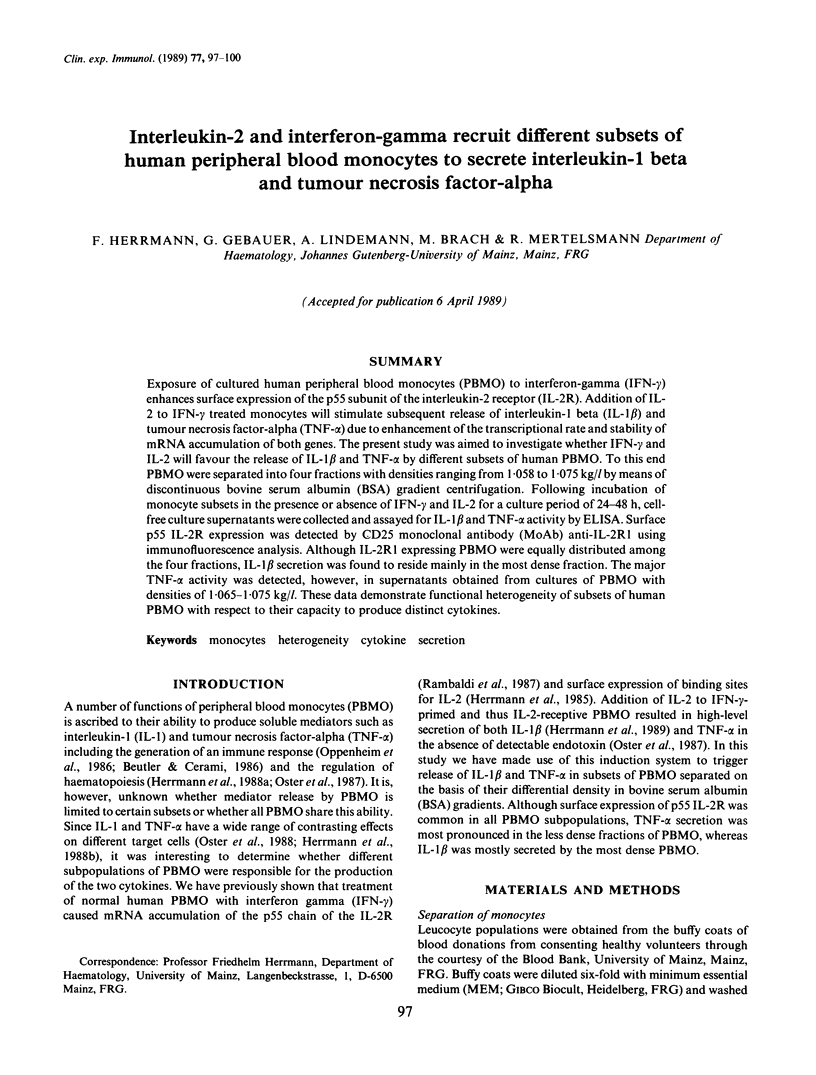Abstract
Exposure of cultured human peripheral blood monocytes (PBMO) to interferon-gamma (IFN-gamma) enhances surface expression of the p55 subunit of the interleukin-2 receptor (IL-2R). Addition of IL-2 to IFN-gamma treated monocytes will stimulate subsequent release of interleukin-1 beta (IL-1 beta) and tumour necrosis factor-alpha (TNF-alpha) due to enhancement of the transcriptional rate and stability of mRNA accumulation of both genes. The present study was aimed to investigate whether IFN-gamma and IL-2 will favour the release of IL-1 beta and TNF-alpha by different subsets of human PBMO. To this end PBMO were separated into four fractions with densities ranging from 1.058 to 1.075 kg/l by means of discontinuous bovine serum albumin (BSA) gradient centrigugation. Following incubation of monocyte subsets in the presence or absence of IFN-gamma and IL-2 for a culture period of 24-48 h, cell-free culture supernatants were collected and assayed for IL-1 beta and TNF-alpha activity by ELISA. Surface p55 IL-2R expression was detected by CD25 monoclonal antibody (MoAb) anti-IL-2R1 using immunofluorescence analysis. Although IL-2R1 expressing PBMO were equally distributed among the four fractions, IL-1 beta secretion was found to reside mainly in the most dense fraction. The major TNF-alpha activity was detected, however, in supernatants obtained from cultures of PBMO with densities of 1.065-1.075 kg/l. These data demonstrate functional heterogeneity of subsets of human PBMO with respect to their capacity to produce distinct cytokines.
Full text
PDF



Selected References
These references are in PubMed. This may not be the complete list of references from this article.
- Beutler B., Cerami A. Cachectin and tumour necrosis factor as two sides of the same biological coin. Nature. 1986 Apr 17;320(6063):584–588. doi: 10.1038/320584a0. [DOI] [PubMed] [Google Scholar]
- Herrmann F., Bambach T., Bonifer R., Lindemann A., Riedel D., Oster W., Mertelsmann R. The suppressive effects of recombinant human tumor necrosis factor-alpha on normal and malignant myelopoiesis: synergism with interferon-gamma. Int J Cell Cloning. 1988 Jul;6(4):241–261. doi: 10.1002/stem.5530060403. [DOI] [PubMed] [Google Scholar]
- Herrmann F., Oster W., Meuer S. C., Lindemann A., Mertelsmann R. H. Interleukin 1 stimulates T lymphocytes to produce granulocyte-monocyte colony-stimulating factor. J Clin Invest. 1988 May;81(5):1415–1418. doi: 10.1172/JCI113471. [DOI] [PMC free article] [PubMed] [Google Scholar] [Retracted]
- Kovacs E. J., Radzioch D., Young H. A., Varesio L. Differential inhibition of IL-1 and TNF-alpha mRNA expression by agents which block second messenger pathways in murine macrophages. J Immunol. 1988 Nov 1;141(9):3101–3105. [PubMed] [Google Scholar]
- Lindemann A., Ludwig W. D., Oster W., Mertelsmann R., Herrmann F. High-level secretion of tumor necrosis factor-alpha contributes to hematopoietic failure in hairy cell leukemia. Blood. 1989 Mar;73(4):880–884. [PubMed] [Google Scholar]
- Oster W., Lindemann A., Horn S., Mertelsmann R., Herrmann F. Tumor necrosis factor (TNF)-alpha but not TNF-beta induces secretion of colony stimulating factor for macrophages (CSF-1) by human monocytes. Blood. 1987 Nov;70(5):1700–1703. [PubMed] [Google Scholar]
- Oster W., Lindemann A., Riedel D., Cicco N. A., Mertelsmann R., Herrmann F. Monokines: stimulatory and inhibitory regulator molecules of myelopoiesis in vitro. J Biol Regul Homeost Agents. 1988 Jul-Sep;2(3):134–138. [PubMed] [Google Scholar]
- Rambaldi A., Young D. C., Herrmann F., Cannistra S. A., Griffin J. D. Interferon-gamma induces expression of the interleukin 2 receptor gene in human monocytes. Eur J Immunol. 1987 Jan;17(1):153–156. doi: 10.1002/eji.1830170127. [DOI] [PubMed] [Google Scholar]
- Shannon B. T., Finkelstein S., Hester J. P., Fudenberg H. H., Merler E. Altered heterogeneity of monocytes in acute myelomonocytic leukemia. J Natl Cancer Inst. 1983 Dec;71(6):1157–1163. [PubMed] [Google Scholar]
- Thorens B., Mermod J. J., Vassalli P. Phagocytosis and inflammatory stimuli induce GM-CSF mRNA in macrophages through posttranscriptional regulation. Cell. 1987 Feb 27;48(4):671–679. doi: 10.1016/0092-8674(87)90245-5. [DOI] [PubMed] [Google Scholar]
- Treves A. J., Barak V., Tal T., Fuks Z. Constitutive secretion of interleukin 1 by human monocytes. Eur J Immunol. 1983 Aug;13(8):647–651. doi: 10.1002/eji.1830130808. [DOI] [PubMed] [Google Scholar]
- Whisler R. L., Newhouse Y. G., Lachman L. B. Heterogeneity of human monocyte subsets in the promotion of B cell colonies and the role of interleukin 1. J Immunol. 1982 Aug;129(2):455–460. [PubMed] [Google Scholar]
- Wieser M., Bonifer R., Oster W., Lindemann A., Mertelsmann R., Herrmann F. Interleukin-4 induces secretion of CSF for granulocytes and CSF for macrophages by peripheral blood monocytes. Blood. 1989 Apr;73(5):1105–1108. [PubMed] [Google Scholar]


